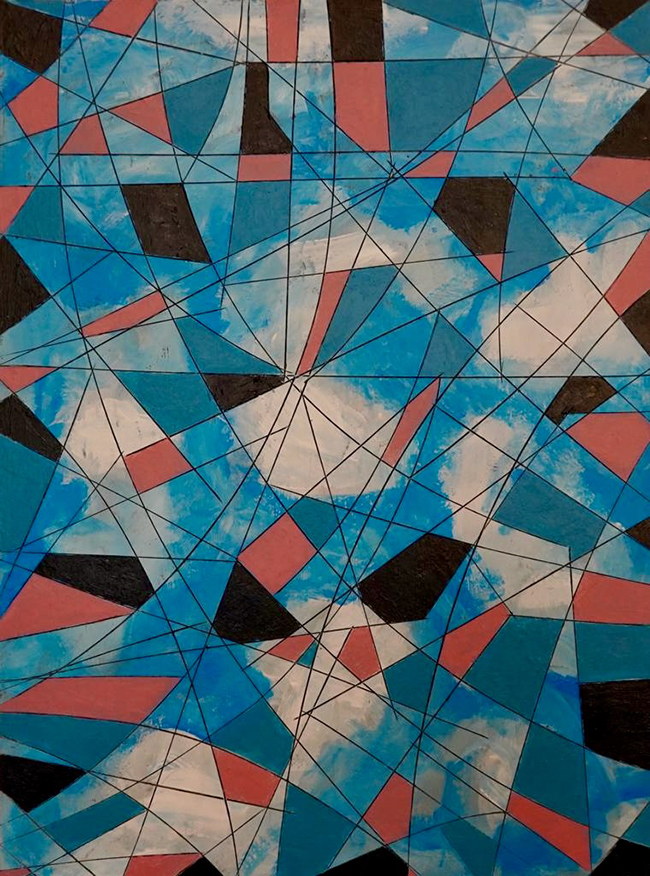Díaz-Piñeiro, a German artist, is a project, aptly titled “Fractals,” that unveils a visual exploration of nature’s intricacies and its potential entanglement with quantum fields. Through small to medium-sized acrylic paintings, Díaz-Piñeiro delves into the abstract, inviting viewers to contemplate the profound connection between humanity and the universe.
The heart of Díaz-Piñeiro’s exhibition lies in the concept of fractality, a notion that mirrors the inherent complexity and self-similarity found in nature. As he immerses himself in the world of abstract painting, Díaz-Piñeiro seamlessly intertwines the aesthetic with the metaphysical. The result is not just a collection of paintings but a subjective contemplation of our place in the vast expanse of the cosmos.

“Fractals” isn’t merely a display of artistic skill; it is a visual representation of Díaz-Piñeiro’s vision, rooted in the influence of metaphysics and its interplay with the quantum field. Díaz-Piñeiro proposes a perspective that extends beyond the dimensions perceivable by the human senses, suggesting that there are other states of existence that elude our vision and touch but remain an integral part of nature.
Díaz-Piñeiro articulates his philosophy, stating, “Everything is mathematically connected somehow; we can’t see it, but we feel it close.” In these words, he encapsulates the essence of his artistic pursuit — a quest to visually articulate the invisible threads that bind us to the intricate tapestry of the universe.

Among Díaz-Piñeiro’s artworks is “Fractal 15,” a night fractal that captures the perpetual motion of trees and the earth in darkness, elements unseen by the naked eye but rendered vividly on canvas. The play of shadows and the suggestion of movement evoke a sense of the unseen forces that govern the natural world.
“Fractal 33” transports viewers to the celestial realm, depicting a sky fractal where clouds dance against the canvas of the blue sky. Geometrical structures, imperceptible in the day-to-day, take center stage, prompting contemplation on the unseen order that shapes the cosmos.
At the heart of the exhibition lies “Fractal 0,” the Human Fractal. This piece serves as both the beginning and the end of Díaz-Piñeiro’s visual journey. It portrays the human observer — the true witness to the universe. In Díaz-Piñeiro’s vision, this observer is in a perpetual connection with nature, serving as a living, breathing part of it. This painting encapsulates the crux of Díaz-Piñeiro’s exploration: the symbiotic relationship between humans and the natural world.
Díaz-Piñeiro’s use of acrylics on small to medium-sized canvases underscores a simplicity that belies the complexity of his subject matter. Each stroke and hue is purposeful, contributing to the overall tapestry of interconnectedness that defines his body of work.

As viewers navigate the exhibition, they are invited to step into Díaz-Piñeiro’s world — a world where the boundaries between the tangible and intangible blur, and the observer becomes an active participant in the dance of the universe. The spartan tone of Díaz-Piñeiro’s work resonates, not through elaborate details, but through the unspoken language of colors and forms.
In a world often characterized by chaos and disconnection, Díaz-Piñeiro’s “Fractals” serves as a poignant reminder of the underlying harmony that binds us all. It prompts viewers to question the limits of perception, encouraging them to acknowledge the unseen forces that shape our existence.
On his one-year anniversary as an artist, Díaz-Piñeiro stands as a testament to the power of simplicity and depth in artistic expression. “Fractals” is not just an exhibition; it is an invitation to ponder the profound, to embrace the unknown, and to recognize our place in the intricate web of the universe. Díaz-Piñeiro’s work challenges us to see beyond the surface, to feel the mathematical connections that bind us, even if we cannot see them. As we celebrate this artist’s contribution to the world of contemporary art, we also celebrate the interconnectedness that defines us all.
